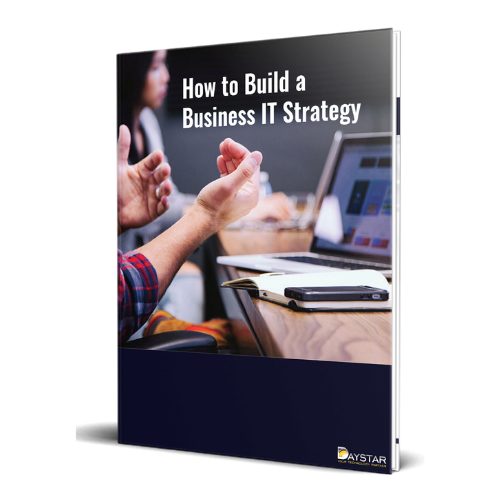How the right IT strategy can drive business growth
Successful business leaders approach IT operations as an opportunity to grow. They don't view information technology as a necessary evil, but a force that can empower a business with a competitive advantage. Technology should align with business objectives and drive outcomes to hit business goals and realize true growth.
To do that, business leaders must embrace a more agile and integrated approach to business IT operations. By incorporating business IT alignment, you can focus efforts on strategic goals and measurable outcomes. This allows you to employ technology smartly and leverage digital transformation initiatives that help your business grow and create competitive advantage.
Is your business plan missing something?
Technology powers your business, but it can also hold it back. As your company grows, make sure your technology solutions can keep up and help you hit your goals. Don't be caught without a plan.
Changing the Conversation from "IT Needs" to Business Strategy
The first step in creating a growth-oriented IT business strategy is to stop focusing on technical problems. Instead, attention should be directed at strategic planning around your business goals and operational objectives. It’s easy to get into the weeds, discussing all your short-term it needs and wants, like updating computers or deciding which antivirus to use. However, it’s more beneficial to spend time planning for how technology can push your business forward.
Technology initiatives are business strategy conversations, not technical ones. Successful projects are strategized at the business level by a cross-functional team of decision makers, like the owner or CEO, operations manager, financial officer, CIO, and the IT department director. Discussion should focus around “why” a project is needed and the expected outcomes it should produce. The reasoning should be tied back to the organization’s strategic goals with the understanding and support of all players.
Some of these growth drivers include:
- Cutting costs through automation or increased employee productivity
- Improving customer experience and service with better communication tools
- Simplifying business operations through streamlined processes
- Mitigating cybersecurity risk with technical, process, and procedural controls
- Removing barriers with collaboration tools to increase employee productivity and satisfaction
- Increasing insight/visibility with measurement, reporting, and review
Although each of the players will go back to their respective teams and work on the tactical nature of implementing it (IT team), paying for it (finance), and integrating it (operations), everyone is still focused on the big picture of IT…. growing the business.
Smart IT strategy initiatives focus on Business Outcomes
When we work with our clients, we center discussions around three main business outcomes:
Growth and Productivity
Whether it is a new technology implementation or ongoing, everyday technical support, all IT functions should support your business’ needs and productivity goals. New IT projects should support future growth and provide the foundation upon which those goals are achieved.
Your IT support should likewise be viewed as a way to enable additional productivity. Managed IT services proactively support your environment to minimize disruptions to your employees thereby increasing their productivity, reducing their frustrations and increasing your overall business performance.
Operations and Visibility
IT systems and technology should serve to increase your operational efficiency by streamlining or automating processes. Resources can then be reallocated to other areas to support operational goals.
Another powerful attribute of technology is in the ability to track and measure it. Defining metrics and analyzing periodic reporting provides businesses with increased visibility and insight to improve decision making.
Risk Mitigation and Security
The risks associated with cyber attacks, human error, and equipment malfunctions will never go away completely. The possibility of a breach is real, along with the damage it inflicts in terms of remediation costs, lost productivity, regulatory fines, and reputation damage. These consequences can adversely impact business growth.
Successful businesses acknowledge and accept risk and put controls and measures in place to minimize the likelihood of an incident and the impact it would make. These measures encompass not only technical solutions, but also business processes, organization policies, and employee training to effectively mitigate risk.
Creating a Roadmap for Smart IT strategy
How do you implement outcome-focused information technology strategy? Once you’ve changed the conversation and gathered the right people, follow these steps to implement a growth-oriented technology roadmap.
All planning begins with the desired goal in mind. Know what you are trying to achieve and then employ the steps to achieve the outcome.
Standards and Best Practices
Develop and align technology standards and best practices. This sets a solid foundation and supports a consistent, reliable, and optimized technology environment. Your standards and best practices serve as the building blocks to achieving your goals.
Business IT Alignment
Conduct and document a thorough business review to align a technology environment that will facilitate objectives and desired outcomes. Ensure the technical infrastructure adheres to defined standards and best practices. In areas where it doesn’t fall in line with standards, make necessary changes. This ensures that your current business technology environment is in proper alignment.
Business Impact
Review and/or update your strategic business goals. Document, map, and prioritize technology findings to uncover the most significant impact on your business goals. Identify impact areas and incorporate strategic IT initiatives into ongoing strategic planning.
Strategy
Define and execute a comprehensive Business Technology Strategy plan to include: strategic direction, budgeting, goals, outcomes, metrics, and accountability. This provides a complete, aligned business technology roadmap that enables your business to efficiently reach its business objectives.
Once complete, it’s okay to take a moment and pat yourself on the back. However, don’t take all that work and put it up on the proverbial shelf. Plans, policies, documentation, and budgeting should be periodically reviewed and updated. In addition, these tools should serve as your guiding principles when embarking on any new technology initiatives.

Growth Technology
Successful businesses don’t view technology simply as a way to automate processes, but also use it to create new opportunities and ways of doing business. When used deliberately in the right circumstances, virtually any technology can contribute to a business’ growth strategy.
Many of the small businesses we work with are using the following technology strategies to promote company growth.
Cloud computing technologies
Cloud solutions allow a small business to take advantage of enterprise technologies that were previously out of reach due to cost constraints or complexity. The ability to scale the solution easily and pay only for what you need can make them extremely cost-effective. Cloud productivity platforms enable small businesses to realize efficiencies and increase collaboration.
Mobile technologies
Coupling cloud technologies with a mobilization strategy can further promote business growth. Equipping your team with laptops, tablets, smartphones and remote connectivity creates additional opportunities for productivity, communication, and employee flexibility. Mobile apps put the data you need right at your fingertips, regardless of where you are.
Social Media
Properly leveraging social media technology can further support growth goals through social marketing, sales development, lead generation, and social networking. Although some people perceive social media as a B2C tool, it’s become increasingly sophisticated and its scope has expanded so widely that, when used well, social platforms can be powerful B2B growth tools.
Align Your IT and Business Strategy
Employing a successful growth-oriented technology strategy requires engagement from all sides – from executive, to operations, to financial, to technical representation. This is the first step to true business alignment and digital transformation. Working together, your IT leaders, whether internal employees or outsourced service providers, and business operations executives can align your IT support and IT strategy with defined organizational objectives and outcomes that will contribute to your business success and growth.
This involves shifting the business model from the traditional top-down approach to a more agile, integrated process. Whereas technology initiatives traditionally originated from the business owner or operational manager as marching orders for the IT team to complete, a business IT alignment approach more closely integrates IT into every major business process, including operations, human resources, and finance. As an integrated team, they, in turn, bring strategic technology initiatives to the CEO or business owner.
Why does this matter? The more modern, agile approach that effectively leverages business alignment with digital transformation strategy realizes a true competitive advantage. A more informed, deliberate, and strategic business model sets your business apart from the competition and enables you to reach business goals faster and grow more efficiently.
Employing a smart IT strategy coupling business alignment and digital transformation is a process that takes time and requires buy-in from your organization’s operational, business, and IT leaders. The advantages and opportunities it brings your business make it well worth the investment.
Follow Our Learning Center for the Latest Developments in Technology and IT Support!
 |
||
















